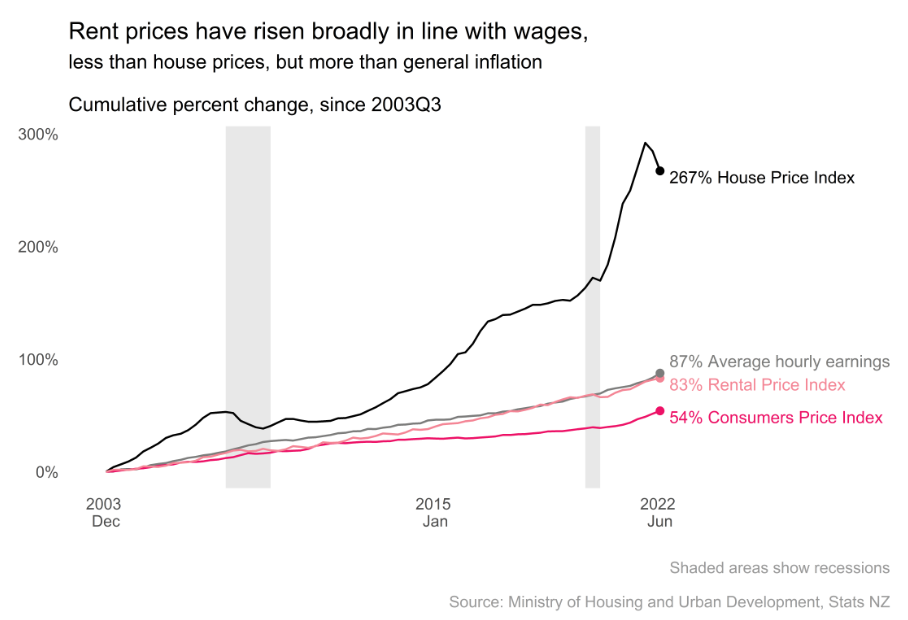What drives rents in New Zealand?
The analysis in this paper was carried out by Alan Bentley, Enzo Cassino and Nam Ngo through the Housing Technical Working Group (HTWG). The HTWG includes staff from the 3 agencies.
Over the last 20 years, wage rises and the relative supply and demand of homes were the 2 key drivers of rents at both the national and regional level, the paper shows.
Research paper — What drives rents in New Zealand?
National and regional analysis
Read the research paper on the Treasury website
“A 1% increase in the average number of people in each home, an indicator of relative supply and demand, leads to a 1.5% increase in rents at the national level.” This link between rents and the number of people in each home could occur for several reasons, such as, that rents tend to rise when there are not enough houses to go around, or that renters tend to share accommodation more when rents rise.
The study found rents increase when mortgage interest rates rise, but the impact is quite small. “This is consistent with previous analysis done by the Housing Technical Working Group on the impact of land supply restrictions.” This is because when land supply is highly constrained, we would expect financial factors, such as interest rates, to have a greater impact on house prices than rents.
Understanding these key drivers of rents is important to monitor and assess the balance of supply and demand in the housing market, enhance government policy for renters, improve the accuracy of house price forecasts, and identify potential hot spots at the regional level.
The share of New Zealand households who pay rent has increased significantly during the past 3 decades, rising from about 23% in 1991 to 32% in 2018. The number of rented homes rose from about 290,000 in 1996 to 530,000 in 2018.
“Rents matter since low-income households have little discretion over how much they must spend to put a roof over their heads,” the authors say. “Renters typically earn less than homeowners, spend a greater share of their pay on housing, and are less wealthy.”
Between 2003 Q3 and 2022 Q2, rents increased broadly in line with wages, but faster than inflation.
- New tenancy rents increased a cumulative 83%
- Average hourly earnings up 87%
- Consumer prices (CPI) rose 54% and,
- House prices 267%
-
The HTWG identified these differing growth rates, amongst other things, as evidence to support their conclusions presented in the Assessment of the housing system with insights from the Hamilton-Waikato area on the Treasury's website. (HTWG, 2022).
Key findings from the paper
- Understanding the key drivers of rents is important to monitor and assess the balance of supply and demand in the housing market, improve the accuracy of house price forecasts, and identify potential hot spots at the regional level.
-
- Wage inflation and relative supply and demand of dwellings (measured by people per dwelling) are the 2 key drivers of rental inflation for new tenancies at the national level.
-
- The impact of mortgage interest rates on rents is positive but quite small. This is consistent with previous analysis done by the Housing Technical Working Group on the impact of land supply restrictions.
- The identified key drivers are robust to local circumstances, although unobserved region-specific factors can dampen or magnify the effects in particular regions.
Why we did this research
New Zealand rental prices have received growing attention as the proportion of people who rent has been increasing since the early 1990s. This paper aims to provide an initial framework to improve our understanding of the factors that impact housing rentals in New Zealand.
This analysis is useful for several reasons. Firstly, rents provide a better signal of the balance of supply and demand for dwellings than house prices do. This is because rent prices do not reflect expectations for future gains as house prices do.
Secondly, providing a better understanding of rent drivers can lead to better government policy as renters typically pay a larger proportion of their incomes on housing costs than owner occupiers and so they are more vulnerable to large movements in housing costs.
Thirdly, forecasting rents can also improve the accuracy of house price forecasts, as they are one of the factors that influence house prices.
Finally, the research helps us to test theories of how land and housing markets operate.
























































First, please LoginComment After ~